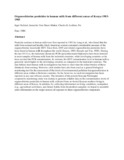| dc.description.abstract | Pesticide residues in human milk were first reported in 1951 by Laug et aI., who found that the milk from normal and healthy black American women contained considerable amounts of the organochlorine insecticide DDT. Since then, DDT and related organochlorine pesticides have been found in human milk throughout the world (Jensen, 1983; Siorach and Vaz, 1983). During the last 10-13 yr, the industrial chemicals PCBs (polychlorinated biphenyls) have been detected in most samples of human milk from the industrial countries, while developing countries so far have avoided the PCB contamination. In contrast, the DDT contamination level in human milk is generally much higher in the developing countries as compared to the industrial countries.
The idea behind most human milk investigations has been to eluci¬date the infant burden of these chemicals from nursing. However, such studies have also been used as a general biological monitoring tool for the assessment of the levels of environmental pollution byorganochlorines in different areas within or between countries. So far, however, no such investigation has been reported in any east African country.
The intention of the present Kenyan-Norwegian cooperative monitoring study was mainly to generate reliable data on the contamination levels of organochlorine pesticides in human milk collected from se¬lected Kenyan mothers living in different areas of Kenya. In addition, by collecting information on living conditions, occupation (e.g., agricultural activities), and dietary habits from the mothers sampled, we hoped to assemble some information on the major sources of exposure to these organochlorine compounds. | en |

